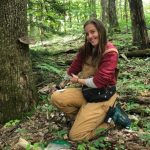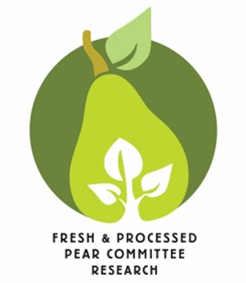Written by Molly Sayles, Robert Orpet, and Louis Nottingham, WSU Entomology. November 28th, 2022.
The 2022 pear season has come to a close and so has the first year of the pear psylla phenology-based IPM project. This program is based on controlling pear psylla through optimal timings of insecticides by using a new phenology model developed by Vince Jones of WSU in 2019 (Figure 1). The associated guidelines are publicly available (https://treefruit.wsu.edu/crop-protection/psylla-phenology-model/). Pear psylla degree days were shared publicly on the guidelines webpage for select weather stations in the main pear growing regions in 2022 and will continue to be shared with weekly updates in 2023.
Figure 1: Pear psylla phenology model and generalized management strategy timings
From March through October 2022, our team monitored 19 orchards in the Wenatchee River Valley: 8 IPM, 8 conventional, and 3 organic. IPM blocks followed the phenology-based management guidelines while conventional blocks used the growers’ standard programs with broad-spectrum insecticides. Scouting procedures and seasonal data for pear psylla, mites, and natural enemies can all be found on our public scouting page.
IPM was as effective as conventional management at controlling pear psylla
At harvest, we rated Anjou pear psylla marking damage using packing-house standards (Figure 2). We found that IPM and conventional had about the same amount of US1 pears (89%) as conventional ones (92%). In some areas, the IPM orchard outperformed the paired conventional orchard and vice versa, so it is important to recognize the variation in outcomes for both IPM and conventional management.
Although damage averaged out to be similar between programs, damage occurred at different times. In spring, conventional and IPM had similar pear psylla abundances. Damage mainly occurred in IPM orchards during summer. In July, we saw higher numbers of second-generation summerform pear psylla adults in IPM and organic blocks, with conventional blocks having low numbers through August. In August, the reverse occurred. Pear psylla nymphs and adults decreased in IPM and organic blocks while increasing in conventional (Figure 3). This trend became especially pronounced in September and October when conventional sites had an exorbitant increase in psylla adults around harvest (Figure 3). Our damage assessments may underestimate economic loss in conventional orchards, where sticky pears at harvest discourage pickers and risk causing damage if fruit sits long before washing at the packing house.
Differences in pear psylla and timings of damage are due to natural enemies (i.e., insect predators and parasitoids). Although IPM blocks experienced higher pear psylla numbers in the early summer generation, natural enemies grew in those plots by July and August, which kept the harvest-time psylla generation suppressed. On the other hand, conventional blocks eliminated natural enemies with broad-spectrum sprays, resulting in an unchecked population around harvest and leading to a five-fold increase in psylla adults in September (Figure 2).
Figure 2: Mean percentage (with standard error bars) of US1 Anjous in 8 IPM and 8 conventional pear blocks.
Figure 3: Summary graphs of pear psylla adults, eggs, nymphs, and natural enemies from June through September 2022 at 8 conventional, 8 IPM, and 3 organic blocks.
IPM costs less than conventional management
We are currently working on a cost analysis based on spray records from each site. As of now, we have analyzed three paired sites and have found IPM to be less expensive than conventional: IPM cost average was $1100/acre, while conventional was $1400/acre (Figure 4).
Figure 4: Mean cost (with standard error bars) of insecticide materials per acre in 3 IPM and 3 conventional blocks.
Conclusion and the future
IPM works by having a spray program that promotes natural enemies, which provided effective (and free!) control of pear psylla. This season revealed that IPM can control pear psylla as effectively as conventional management while being less expensive. Our team will continue to monitor the same sites next season, and potentially add more.
We expect IPM to work even better next year because natural enemies have built up and will likely have higher overwintering populations near the study orchards. More broadly, as explained in last month’s newsletter we expect that the more orchards there are that use IPM, the better it will work. Conventional orchards produce high pear psylla populations in fall due to their lack of natural enemies. These adults overwinter and spread areawide in spring, causing the valley to have extremely high area-wide psylla pressure. Conversely, IPM orchards have natural enemies and very low populations of pear psylla in fall, which will result in area-wide decreases in pear psylla as more people start to adopt IPM.
To improve the IPM phenology program, we plan to distribute an annual survey beginning this winter for feedback, expect to see the survey in a future edition of Tree Fruit Matters!
Contacts
Molly Sayles
Ph.D. student
WSU Tree Fruit Research & Extension Center
1100 N Western Ave., Wenatchee, WA 98801
molly.sayles@wsu.edu
Dr. Louis Nottingham
Assistant Professor, Entomology
Washington State University
540-798-2044 (cell)
louis.nottingham@wsu.edu
Dr. Robert Orpet
Research Assistant Professor, Entomology
Washington State University
Robert.orpet@wsu.edu
Funding and acknowledgments
Additional information
Pear Psylla Integrated Pest Management Factsheet
Commercial evaluations of the Phenology IPM Program
Fruit Matters articles may only be republished with prior author permission © Washington State University. Reprint articles with permission must include: Originally published by Washington State Tree Fruit Extension Fruit Matters at treefruit.wsu.edu and a link to the original article.
Use pesticides with care. Apply them only to plants, animals, or sites listed on the labels. When mixing and applying pesticides, follow all label precautions to protect yourself and others around you. It is a violation of the law to disregard label directions. If pesticides are spilled on the skin or clothing, remove the clothing and wash the skin thoroughly. Store pesticides in their original containers and keep them out of the reach of children, pets, and livestock.
YOU ARE REQUIRED BY LAW TO FOLLOW THE LABEL. It is a legal document. Always read the label before using any pesticide. You, the grower, are responsible for safe pesticide use. Trade (brand) names are provided for your reference only. No discrimination is intended, and other pesticides with the same active ingredient may be suitable. No endorsement is implied.









